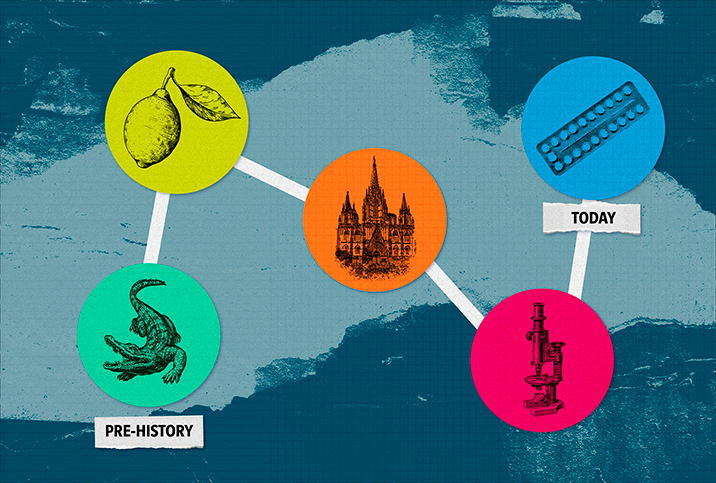The (Often Tragic) History of Abortion Technology

The Museum of Contraception and Abortion sits on an unassuming side street of Austria's capital city, Vienna. The airy, two-room space is dedicated to telling humans' long history of avoiding and ending pregnancy.
The museum was founded by Christian Fiala, M.D., Ph.D., an OB-GYN who provides abortions in countries in Africa and Asia where the procedure is banned. Fiala, who has witnessed firsthand the often devastating effects of denying people access to safe abortions, said he opened the museum to remind people of "the basic facts."
"It's part of life: We can't get rid of unwanted pregnancies," Fiala said. "We only have the choice to allow it and have it safe or to make it illegal, in which case it will happen anyway but will threaten the health and lives of women."
A modern-day abortion performed under typical circumstances is one of the safest medical procedures we have, according to Fiala.
"On the other hand, this extremely safe procedure can become very dangerous and even lethal if it is performed by an unqualified person under illegal circumstances with unsuitable instruments," he said.
Abortion in the ancient world: Pennyroyal and pestles
The earliest surviving record of abortion appears in the Ebers Papyrus (1550 B.C.), an Egyptian medical text that details different herbal remedies to induce a miscarriage. One recipe instructs: "To cause a woman to stop pregnancy in the first, second or third period: unripe fruit of acacia, colocynth, dathes, titurate with 6/7 pint of honey; moisten a pessary of plant fiber and place in the vagina."
In ancient Greek and Roman societies, abortion was used as a method of population control. Ancient texts are riddled with references to abortifacients such as pennyroyal, a highly toxic herb that in addition to causing miscarriages can also cause multiorgan failure and death if ingested.
The earliest known depiction of abortion is from Cambodia in 1150 A.D. The bas-relief sculpture, which decorates the temple of Angkor Wat, shows pregnant women being beaten in the abdomen with pestles. This kind of "massage abortion" is still practiced in Myanmar, Indonesia and the Philippines, where abortion is illegal.
Abortion in medieval Europe: Wise women and wild ginger
While medieval societies were repressive toward women and ignorant of reproduction management, historians believe abortion was commonplace. In his book, "A History of Contraception and Abortion in the West," author John M. Riddle explained that medieval-era midwives or "wise women" prescribed herbal abortifacients made from plants such as pennyroyal and yarrow.
Hildegard von Bingen, a 12th-century nun, famously prescribed abortifacients and treatments for "retention of the menses." For example, von Bingen prescribed the herbal abortifacient Asarum, also known as European wild ginger or wild spikenard, to end a dangerous pregnancy, writing: "A pregnant woman will eat it, either on account she languishes or she aborts an infant which is a danger to her body, or if she has not had a menstrual period for a time period so that it hurts."
Abortion in early America: Cotton root and calomel
Abortions were common in the 17th, 18th and early 19th centuries, according to Jennifer Holland, Ph.D., an assistant professor of U.S. history at the University of Oklahoma and the author of "Tiny You: A Western History of the Anti-Abortion Movement." During this period, abortion was considered legal until a period called "the quickening," or when the woman felt the fetus kick, usually within four to six months of conception.
"Pre-quickening" abortions during this time period typically involved ingesting "herbal concoctions" provided by a midwife, Holland said. Herbal abortifacients such as pennyroyal and the similarly toxic savin and tansy could be concocted and self-administered to "restore menstruation."
Holland said there's some disagreement over why post-quickening abortions were illegal, but the reason likely had less to do with concern for the fetus's soul and more to do with the perils of performing a procedure late in the pregnancy.
Later-term abortions could not be performed with abortifacients—already highly risky—and instead required the even more treacherous surgical intervention, she explained.
"And any kind of surgery in the 19th century would be very dangerous because people didn't know how to sterilize instruments, and infections were incredibly common," Holland said.
Abortion was more tightly restricted for enslaved women because slaveholders viewed their children as property. Enslaved pregnant women relied on herbal remedies—knowledge passed down generationally—to induce abortions, chewing cotton root and taking toxic substances such as calomel and turpentine.
Abortion in early 20th-century America: Coat hangers and knitting needles
Everything changed in the mid- to late 19th century when the first antiabortion laws began to surface, according to Kimberly Hamlin, Ph.D., professor of history and global and intercultural studies at Miami University in Oxford, Ohio.
"That's when we start seeing abortion become criminalized because of larger trends, including the professionalization and masculinization of medicine," Hamlin explained.
Despite changing laws, abortions remained prevalent. "Outlawing them just made them unsafe," Hamlin said. The prevalence and risk of illegal abortion were evidenced in the death toll: In 1930, abortion was the official reported cause of death for 2,700 women—18 percent of total maternal deaths that year. The death rate declined in the following years with the invention of antibiotics, but abortion still accounted for 17 percent of reported deaths related to pregnancy in 1965. Facing life or death, people still wanted to get rid of an unwanted pregnancy.
What did these illegal abortion procedures look like? According to Fiala, many designated medical abortion tools can be a giveaway, so women and back-alley abortion providers used whatever instruments they could find: Anything long and thin enough to reach the uterus could do the job.
"In the U.S., it was the coat hanger," Fiala said. "In Europe and places like New Zealand, metal coat hangers are not so common, so you would use a knitting needle."
Fiala was quick to add that these methods are highly perilous, and Bhavik Kumar, M.D., M.P.H., a board-certified family medicine physician and medical director for primary and trans care at Planned Parenthood Gulf Coast in Houston, agreed.
"It is extremely dangerous to insert objects into your body without knowledge and understanding of what you are doing," Kumar said, adding that the use of physical methods can result in serious or grave injury. For example, a perforation of the bowel or bladder can cause infection, including to the level of sepsis or even death if not treated in a timely manner.
Abortion in 1970s America: Del-Em devices
It's worth noting that not everyone resorted to knitting needles or bicycle spokes in the 20th century. In 1971—two years before the Supreme Court's landmark Roe v. Wade decision struck down an abortion ban and affirmed the constitutional right to an abortion—a group of feminist activists invented a homemade suction device called Del-Em.
Abortion activists Lorraine Rothman and Carol Downer fashioned the device from a Mason jar, a one-way valve and two lengths of plastic tubing from a tropical fish store. In this form, the device could be used by someone with minimal experience to perform an abortion in as little as 30 minutes in a woman's home up until eight weeks of pregnancy.
In 1971, Rothman and Downer began teaching other activists how to perform abortions using the Del-Em. The activists traveled around the country, boxes of speculums and menstrual extraction kits in tow, teaching women how to perform the procedure throughout the '70s.
While a huge improvement on many other back-alley abortion methods, the Del-Em was not without safety concerns. The risks had less to do with the Del-Em itself than the necessity to distribute the devices underground, where they were used by people with minimal training or medical knowledge.
Modern abortion technology
Today, there are several ways to safely perform an abortion. The most common method is a medical abortion, which ends a pregnancy through the use of medication and can be self-administered. Other abortion methods include vacuum aspiration and dilation and evacuation (D&E), both of which are performed in clinics or hospitals.
Thanks to legal access to these procedures, deaths from abortion significantly decreased in the decades after the Roe v. Wade ruling. Getting rid of an unwanted pregnancy didn't have to be done in back alleys anymore.
However, the constitutional right to abortion procedures was overturned June 24, 2022, effectively clearing the way for states to restrict access or ban abortion outright. The decision has health experts like Kumar concerned for a future that resembles the past before Roe.
"Any time abortion is banned or restricted, the need for abortion does not go away," Kumar warned. "When abortion goes underground and unregulated, it can lead to dangerous outcomes and most certainly will increase maternal mortality."
Editor's note: Abortion is a medical procedure that is currently illegal or restricted in some portions of the United States. For more information about the legality of abortion in your area, please consult a local healthcare provider.


















